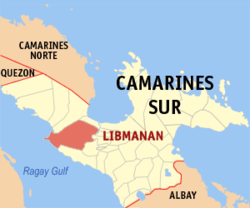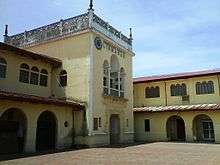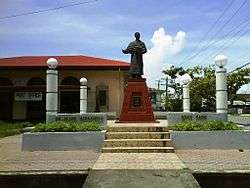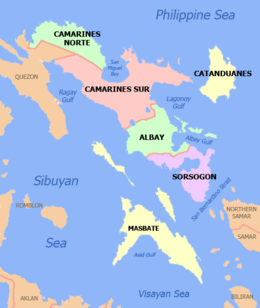Libmanan, Camarines Sur
| Libmanan | ||
|---|---|---|
| Municipality | ||
|
J. Hernandez Park Libmanan | ||
| ||
| Nickname(s): Rice Granary of Camarines Sur | ||
 Map of Camarines Sur showing the location of Libmanan | ||
.svg.png) Libmanan Location within the Philippines | ||
| Coordinates: 13°42′N 123°04′E / 13.7°N 123.07°ECoordinates: 13°42′N 123°04′E / 13.7°N 123.07°E | ||
| Country | Philippines | |
| Region | Bicol (Region V) | |
| Province | Camarines Sur | |
| District | 2nd district | |
| Founded | April 3, 1574 | |
| Barangays | 75 | |
| Government[1] | ||
| • Mayor | Bernard P.Brioso | |
| Area[2] | ||
| • Total | 342.82 km2 (132.36 sq mi) | |
| Population (2015 census)[3] | ||
| • Total | 108,716 | |
| • Density | 320/km2 (820/sq mi) | |
| Time zone | PST (UTC+8) | |
| ZIP code | 4407 | |
| IDD : area code | +63 (0)54 | |
| Income class | 1st class; partially urban | |
Libmanan is a first class municipality in the province of Camarines Sur, Philippines. According to the 2015 census, it has a population of 108,716 people.[3]
History
Libmanan was a bario of Quipayo in 1580 with the name of "Piglabanan". Records from a historian revealed that the municipality was named Libmanan on September 15, 1574. Missionaries started working in Libmanan in 1589 and the area's church was dedicated to St. James the Apostle. Several local stories hint as to the origin of the town’s name. One was that “ligmanan” means "a place surrounded with waterways". Another was Libangan since visitors forgot their former homes because they were said to be “na libang” or "enjoying themselves" - Libangan can also translate to "place of enjoyment". Another version was associated with the conditions during years of moro raids where area was called “Linabanan”, a battle ground. In the Old Spanish Records, Fray Pasqual de la Cruz, writes the name of the town as "Libñanan" the Spanish way of pronouncing the word. The same Record also show that in 1823, Fray Francisco Valverde wrote it as "Libmanan" because it was easier to write and pronounce as well.
German ethnographer Fedor Jagor described visiting Libmanan in his 1875 work "Travels in the Philippines", wherin he visited the local parish priest and learned from him about an ancient human settlement that had been dug up in 1851 during road construction in the Poro area of the southwest close near the Tres Marias islands: the excavation consisted of "numerous remains of the early inhabitants—skulls, ribs, bones of men and animals, a child’s thighbone inserted in a spiral of brass wire, several stags’ horns, beautifully-formed dishes and vessels, some of them painted, probably of Chinese origin; striped bracelets, of a soft, gypseous, copper-red rock, gleaming as if they were varnished; small copper knives, but no iron utensils; and several broad flat stones bored through the middle; besides a wedge of petrified wood, embedded in a cleft branch of a tree." [4]
During the occupation of their country by the United States, the Philippine Legislature greatly expanded the network of railroads throughout the island of Luzon, and a railway headed to the city of Legazpi, Albay and Naga, Camarines Sur was built through Libmanan to provide direct access to those cities.[5] This railway was damaged severely during World War II, but partially restored using American funds thereafter, providing transportation service down the Bicol Peninsula off and on until ending in 2012 despite plans to rehabilitate the route.[6]
Even during the time of the Spaniards, the town of Libmanan was already considered the "rice basket" of the province. This generous production of rice is attributed to the fertile soil and the town's abundant water supply. In 1991 the area's irrigation canals (shared with its northern neighbor Cabusao, Camarines Sur) were sufficient to water 2996 hectares of land during the dry season.[7]
Important Dates & Events
- The first name of town was "Piglabanan".
- March 18, 1484: Invasion of the Moros; those who killed were buried beside the Present Church.
- February 1572: Construction of the First Church.
- September 15, 1574: Changing the town name from Piglabanan to Libmanan by fray Bartolome Cabello.
- 1586-1589: Construction of the Second Church of Libmanan.
- 1732: Start of the first town government of Libmanan.
- 1838: Construction of Catholic Cemetery In Brgy. Puro Batia.
- 1903: Founding of the first public schools.
- 1915: Construction of the municipal cemetery In Brgy. Puro Batia.
- 1921: Construction of the Rizal Monument.
- 1927: Passing of the MRR Co. in Libmanan.
- 1929: Construction of MRR Co. (Philippine National Railways) Bridge.
- 1930-31: Installation of the water system.
- 1933: Construction of first and second market pavilion.
- 1939-40: Construction of a concrete municipal hall under Mayor Francisco Frondozo.
- 1941: Construction of the post office under Mayor Teodoro Dilanco
- March 3, 1951: Naming of Brgy. Bagumbayan by Municipal Council.
- 1954-57: Construction of the municipal irrigation system.
- 1955: Renaming the streets of the Poblacion and improvement of the Town Plaza.
- 1956: Construction of the 30-Door Market.
- May 1957: Dredging of the Libmanan River
- 1957: Construction of a two-story building for the private Central School and also a public toilet.
- March 1961: Construction of the concrete Easter tower under Mayor Amadeo Castaneda.
- 1978: Construction of the Bulaong Bridge.
- 1993: Construction of the Libmanan Town Arc in Brgy. Potot.
Geography

Libmanan is an extremely large municipality, one of the biggest in Camarines Sur. It stretched across nearly the whole width of the Bicol peninsula, from where it borders Cabusao Municipality on the San Miguel Bay all the way out to the Ragay Gulf, including three islands known locally as the 'tres Marias', including one island known as 'puro island'. The main town, or 'poblacion', is located along the Libmanan River on the lowland alluvial plain adjacent to Cabusao.
Heading to the southern coast from the poblacion the municipality becomes hilly. In this hilly region between the poblacion and the highway lies the Libmanan Caves National Park. Continuing on towards the coast from the hills, the municipality becomes truly mountainous beginning in Barangay Malinao beyond the Pan-Philippine Highway, where the "Boro-Boro Spring Resort" is located; a series of waterfalls that are a locally popular swimming destination.[8] Beyond Malinao the upland region features the mountain 'Tancong Vaca' - in the local dialect meaning 'the cow's hump' - which is a local landmark visible from most locations on the Pan-Philippine Highway in western Camarines Sur and was a base of operations for local guerrillas fighting the Japanese during World War II.[9] Up to the present day, the area around Tancong Vaca has remained an area of conflict between anti-government insurgents and the Philippine National Police.[10]
The municipality's rural barangays lie behind Mount Tancong Vaca, and mostly lack access to paved roads, of which there is only one which terminates in the fishing village of Barangay Bahao, within sight of the tres Marias.
Barangays
Libmanan is politically subdivided into 75 barangays;[2] five of which are located in the coastal areas and the remaining 70 barangays are distributed in the low land and upland portions of the municipality. Its town center, poblacion or centro, is 7.7 kilometres (4.8 mi) away from the National Highway. The road leading to Poblacion and other major baranggays is marked by a memorial for the Ten Outstanding Young Men trophy awarded to a past mayor and local hero, Jose Bulaong.
- Aslong
- Awayan
- Bagacay
- Bagadion
- Bagamelon
- Bagumbayan
- Bahao
- Bahay
- Beguito Nuevo
- Beguito Viejo
- Bigajo Norte
- Bigajo Sur
- Bikal
- Busak
- Caima
- Calabnigan
- Camambugan
- Cambalidio
- Candami
- Candato
- Cawayan
- Concepcion
- Cuyapi
- Danawan
- Duang Niog
- Handong
- Ibid
- Inalahan
- Labao
- Libod I
- Libod II
- Loba-loba
- Mabini
- Malansad Nuevo
- Malansad Viejo
- Malbogon
- Malinao
- Mambalite
- Mambayawas
- Mambulo Nuevo
- Mambulo Viejo
- Mancawayan
- Mandacanan
- Mantalisay
- Padlos
- Pag-Oring Nuevo
- Pag-Oring Viejo
- Palangon
- Palong
- Patag
- Planza
- Poblacion
- Potot
- Puro-Batia
- Rongos
- Salvacion
- San Isidro
- San Juan
- San Pablo
- San Vicente
- Sibujo
- Sigamot
- Station-Church Site
- Taban-Fundado
- Tampuhan
- Tanag
- Tarum
- Tinalmud Nuevo
- Tinalmud Viejo
- Tinangkihan
- Udoc
- Umalo
- Uson
- Villasocorro
- Villadima (Santa Cruz)
Demographics
| Population census of Libmanan | ||
|---|---|---|
| Year | Pop. | ±% p.a. |
| 1990 | 77,565 | — |
| 1995 | 85,337 | +1.81% |
| 2000 | 88,476 | +0.78% |
| 2007 | 92,839 | +0.67% |
| 2010 | 100,002 | +2.74% |
| 2015 | 108,716 | +1.60% |
| Source: Philippine Statistics Authority[3][11][12] | ||
In the 2015 census, the population of Libmanan was 108,716 people,[3] with a density of 320 inhabitants per square kilometre or 830 inhabitants per square mile.
Religion
The religious needs of its people and those of neighboring towns prompted the erection of the Prelature of Libmanan in 1990 and installation the first bishop, Msgr. Prospero N. Arellano . On 25 March 2009 Pope Benedict XVI elevated the prelature to become a diocese with Bishop Jose Rojas Rojas becoming its first bishop.[13]
The Catholic Bishops' Conference of the Philippines lists the following Catholic church parishes of Libmanan:[14]
| Parish | Barangay | Fiesta Day |
|---|---|---|
| St. James the Apostle | Libmanan Centro | July 25 |
| Our Lady of Pillar | San Isidro | October 12 |
| St. Vincent Ferrer | San Vicente | April 25 |
Economy

Libmanan, one of the largest and most populous municipality in the province, benefits from the transportation being offered by the Libmanan River, the railroad and the national highway. Though rail service through Libmanan no longer connects directly to Manila there are still commuter trips available bringing passengers to nearby Naga, Camarines Sur and the route that was reopened in 2015 bringing them all the way to Legazpi, Albay.[15]
Generally, Libmanan soil is adapted for growing different agricultural products. Portions are also adopted to pottery-the making of which has been a local industry for centuries. Libmanan has been the “rice-basket” not only of the province but of Southern Luzon-even during the Spanish regime. In spite of problems encountered by rice farmers, Libmanan maintains its status of being the rice granary of the province.
Education
The Department of Education (Philippines) lists the following schools for Libmanan:[16]
- Tertiary
- CASIFMAS (Libmanan Campus) - Potot, Libmanan
- Luis H. Dilanco Sr. Foundation - Bahay, Libmanan
- Secondary
- Bicol Central Academy - Libod 1,Libmanan
- Colegio del Santisimo Rosario - Station Church Site, Libmanan
- Central Bicol State University Sipocot - Libmanan Extension College (formerly: Bicol Institute of Science and Technology - Libmanan Extension College- Sibujo,Libmanan
- Bahay Provincial High School- Bahay,Libmanan
- San Juan National High School - Handong, Libmanan
- San Isidro National High School - San Isidro, Libmanan
- Palangon High School(National) - Palangon, Libmanan
- Intermediate
- Libmanan North Central School
- Candato Elementary School - Candato, Libmanan
- Libmanan South Central School
- Tarum Elementary School
- Ibid Elementary School - Ibid, Libmanan
- Umalo Elementary School - Umalo, Libmanan
- Fundado Elementary School- Taban-Fundado,Libmanan
- St. Joseph Academy - Potot, Libmanan
- Don Jose Ursua Elementary School - Malinao, Libmanan
- Bikal Elementary School- Bikal, Libmanan
- Duang Niog Elementary School-Duang Niog, Libmanan
- Sixto Bulaong Elementary School- Busak, Libmanan
- San Juan Elementary School - Handong, Libmanan
- Malansad Nuevo Elementary School, Malansad Nuevo Elementary School
List of former Executives of Libmanan

| Dates | Name |
|---|---|
| 1732-1755 | Capt. Josep Domingo Ramos |
| 1756-1758 | Capt. Feipe Medina |
| 1759-1760: | Capt. Jose Guevarra |
| 1761 | Capt. Sebastian De la Cruz |
| 1762-1763 | Capt. Pascual de Lajor |
| 1764 | Capt. Luis Arambulo |
| 1765 | Capt. Francisco Severo |
| 1766 | Capt. Pedro Simon |
| 1767-1768 | Capt. Miguel Damiano |
| 1769 | Capt. Antonio De Leon |
| 1770-1771 | Capt. Domingo De la Concepcion |
| 1772 | Capt. Francisco Catimbang |
| 1773 | Capt. Francisco Del Llagas |
| 1774-1777 | Capt. Domingo De la Cruz |
| 1778 | Capt. Francisco Del Llagas |
| 1779 | Capt. Matias Cabanos |
| 1780 | Capt. Antonio De Leon |
| 1781 | Capt. Miguel Damiano |
| 1782 | Capt. Matias Cabanos |
| 1783 | Capt. Antonio De Leon |
| 1784 | Capt. Domingo De la Concepcion |
| 1785 | Capt. Victorino Simon |
| 1786 | Capt. Pedro Gonzales |
| 1787 | Capt. Tomas Baldesoto |
| 1788 | Capt. Domingo De la Concepcion |
| 1789 | Capt. Luis Arambulo |
| 1790 | Capt. Domingo De la Concepcion |
| 1791 | Capt. Nicholas Tolentino |
| 1792 | Capt. Victorino Simon |
| 1793 | Capt. Francisco Del Llagas |
| 1794 | Capt. Juan De la Cruz |
| 1795-1796 | Capt. Mateo De la Concepcion |
| 1797 | Capt. Miguel De la Concepcion |
| 1798 | Capt. Marcelino De la Trinidad |
| 1799 | Capt. Pedro Baldesoto |
| 1800 | Capt. Francisco Espiritu |
| 1801 | Capt. Clemente Eugenio |
| 1802 | Capt. Francisco del Llagas |
| 1803 | Capt. Juan San Antonio |
| 1804 | Capt. Luis Balaguer |
| 1805 | Capt. Melchor de los Reyes |
| 1806 | Capt. Francisco del Llagas |
| 1807 | Capt. Mariano de los Nieves |
| 1808 | Capt. Juan San Antonio |
| 1809 | Capt. Santiago Arambulo |
| 1810 | Capt. Melchor de los Reyes |
| 1811 | Capt. Tomas de la Soledad |
| 1812 | Capt. Fabiano de Galicia |
| 1813 | Capt. Esteban Anunciacion |
| 1814 | Capt. Juan Ramirez |
| 1815 | Capt. Antonio San Pascual |
| 1816 | Capt. Miguel Juliano Francisco |
| 1817 | Capt. Jose del Puerto |
| 1818 | Capt. Francisco Sta. Maria |
| 1819 | Capt. Pedro Alcantara |
| 1820 | Capt. Pedro Sabino |
| 1821 | Capt. Ambrosio de la Cruz |
| 1822 | Capt. Francisco Custudio |
| 1823 | Capt. Placido Anunciacion |
| 1824 | Capt. Matias Manga |
| 1825 | Capt. Maximo Fernandez |
| 1826 | Capt. Augustin Tolentino |
| 1827 | Capt. Placido Anunciacion |
| 1828 | Capt. Pedro San Pablo Alcantara |
| 1829 | Capt. Maximo Fernandez |
| 1830 | Capt. Mariano Villanueva |
| 1831 | Capt. Vicente Cabanos |
| 1832 | Capt. Ludovico Lopez |
| 1833 | Capt. Martin Gonzales |
| 1834 | Capt. Carlos de los Santos |
| 1835 | Capt. Andres Espiritu |
| 1836 | Capt. Pater de Avila |
| 1837 | Capt. Hilario Domingo |
| 1838 | Capt. Santiago Aguirre |
| 1839-1840 | Capt. Maximo Hernandez |
| 1841 | Capt. Luis Alcantara |
| 1842 | Capt. Sebastian Baldesoto |
| 1843 | Capt. Placido Anunciacion |
| 1844 | Capt. Francisco Espiritu |
| 1845 | Capt. Marianon Natividad |
| 1846 | Capt. Isidro Archangel |
| 1847 | Capt. Rufino Nacianceno |
| 1848 | Capt. Anacleto de los Santos |
| 1849 | Capt. Facundo del Pascual |
| 1850 | Capt. Francisco Gonzales |
| Dates | Name |
|---|---|
| 1851-1852 | Capt. Pacifico Roldan |
| 1853 | Capt. Bruno Sol |
| 1854 | Capt. Salvador Espiritu |
| 1855 | Capt. Mariano Albacarte |
| 1856 | Capt. Aniceto Floresca |
| 1857 | Capt. Victoriano Bautista |
| 1858 | Capt. Casiano Flores |
| 1859 | Capt. Mariano Septimo |
| 1860 | Capt. Mariano Rubi |
| 1861 | Capt. Domingo Durante |
| 1862 | Capt. Ramon Hernandez |
| 1863-1864 | Capt. Juan Hernandez |
| 1865-1866 | Capt. Tomas Durante |
| 1867-1868 | Capt. Juan Razonable |
| 1869-1870 | Capt. Mariano Angeles |
| 1871-1872 | Capt. Agaton Ursua |
| 1873-1874 | Capt. Juan Sanchez |
| 1875-1878 | Capt. Rufino Hernandez |
| 1879-1880 | Capt. Rafael Nacianceno |
| 1881-1882 | Capt. Anacleto Atendido |
| 1883-1884 | Capt. Rufino Hernandez |
| 1885-1886 | Capt. Agustin Abellera |
| 1887 | Capt. Vicente Ursua |
| 1888-1889 | Capt. Agaton Ursua |
| 1890-1891 | Capt. Norberto Durante |
| 1892-1893 | Capt. Celedonio Reyes |
| 1894 | Capt. Raymundo Espiritu |
| 1895-1898 | Capt. Casimiro Onate |
| 1899-1901 | Pres. Celedonio Reyes |
| 1902-1903 | Pres. Francisco Ursua |
| 1904-1905 | Pres. Nicolas Ortiz |
| 1906-1907 | Pres. Ligorio Colores |
| 1908-1910 | Pres. Nicolas Ortiz |
| 1911-1912 | Pres. Antonio Peredo |
| 1913-1915 | Pres. Vicente Aureus |
| 1916-1921 | Pres. Ramon Hernandez |
| 1922-1926 | Pres. Marciano Bagadion |
| 1927-1931 | Pres. Macario Zeda |
| 1932-1937 | Mayor Teodoro Dilanco |
| 1938-1940 | Mayor Francisco Frondozo |
| 1941-1942 | Mayor Teodoro Dilanco |
| 1943-1945 | Mayor Eliseo Portin |
| 1946-1947 | Mayor Policarpo Benitez |
| 1948-1951 | Mayor Policarpo Benitez |
| 1952-1955 | Mayor Teofilo Dilanco |
| 1956-1959 | Mayor Teofilo Dilanco |
| 1960-1971 | Mayor Amadeo Castaneda |
| 1972-1979 | Mayor Jose Bulaong, M.D. |
| October 1979-April 1980 | Actg. Mayor Jose Villaluz, M.D. |
| 1980-1986 | Mayor Jose Bulaong, M.D. |
| March 1986-November 1987 | Mayor Juan Echano (OIC) |
| December 1987-June 1988 | Mayor Ramon Villaluz |
| 1988-1998 | Mayor Teodoro Dilanco III |
| 1998-June 2001 | Mayor Gerardo Atienza,Sr. |
| July 2001-June 2004 | Mayor Rodolfo Jimenez, Sr. |
| July 2004-June 2007 | Mayor Rodolfo Jimenez, Sr. |
| July 2007-June 2010 | Mayor Rodolfo Jimenez, Sr. |
| July 2010 – June 2016 | Mayor Marilyn Jimenez |
| July 2016 – Present | Mayor Bernard Brioso |
References
- ↑ "Municipalities". Quezon City, Philippines: Department of the Interior and Local Government. Retrieved 3 January 2013.
- 1 2 "Province: CAMARINES SUR". PSGC Interactive. Makati City, Philippines: National Statistical Coordination Board. Retrieved 3 January 2013.
- 1 2 3 4 "Region V (BICOL REGION)". Census of Population (2015): Total Population by Province, City, Municipality and Barangay (Report). PSA. Retrieved 20 June 2016.
- ↑ Jagor, Fedor (1875). Travels in the Philippines. London: Chapman and Hall. p. 155. ISBN 9781230389998.
- ↑ http://web.archive.org/web/20090227040648/http://pnr.gov.ph/history.htm
- ↑ http://www.rappler.com/nation/94477-pnr-bicol-train-december-2015
- ↑ Bagdion, Benjamin (1991). Joint Management of the Libmanan-Cabusao Pump Irrigation System between Farmers and the National Irrigation Administration in the Philippines (PDF). International Water Management Institute. pp. 1–4. Retrieved 19 June 2014.
- ↑ malinao libmanan. Youtube https://www.youtube.com/watch?v=_NwDJ0ZEKgQ. Retrieved 10 July 2014. Missing or empty
|title=(help) - ↑ Escandor, Juan (March 5, 2009). "Homegrown WW2 vets wait to receive call for recognition". Bicol Mail. 25 (38).
- ↑ "NPA warns Camarines Sur Mayors on allowing town cops in counter-insurgency combat operations.". bicoltoday.com. Bicol Today. 23 March 2015. Retrieved 25 March 2016.
The warning came up when four (4) policemen were wounded by guerillas of the Norben Gruta Command-New People’s Army (NGC-NPA) in a firefight Friday, March 13, at Barangays Pag-oring and Malinao in Libmanan, Camarines Sur.
- ↑ "Region V (BICOL REGION)". Census of Population and Housing (2010): Total Population by Province, City, Municipality and Barangay (Report). NSO. Retrieved 29 June 2016.
- ↑ "Province of Camarines Sur". Municipality Population Data. LWUA Research Division. Retrieved 24 July 2013.
- ↑ Vatican Daily Bulletin (in Italian)
- ↑ http://www.cbcponline.net/libmanan/html/parishes.html
- ↑ http://newsinfo.inquirer.net/725131/pnr-starts-train-runs-from-naga-to-legazpi
- ↑ http://ebeis.deped.gov.ph/beis/reports_info/masterlist
External links
| Wikimedia Commons has media related to Libmanan, Camarines Sur. |
- Official Site of the Diocese of Libmanan
- Philippine Standard Geographic Code
- Philippine Census Information
- Official Site of the Province of Camarines Sur
 |
Sipocot / Cabusao | Bombon |  | |
| Ragay Gulf | |
Magarao Canaman | ||
| ||||
| | ||||
| Pasacao | Pamplona |


